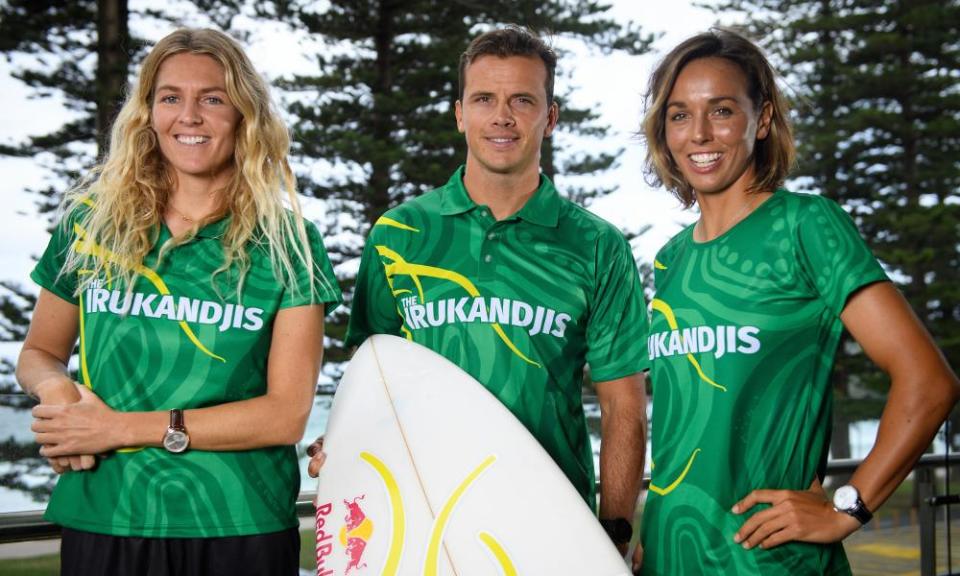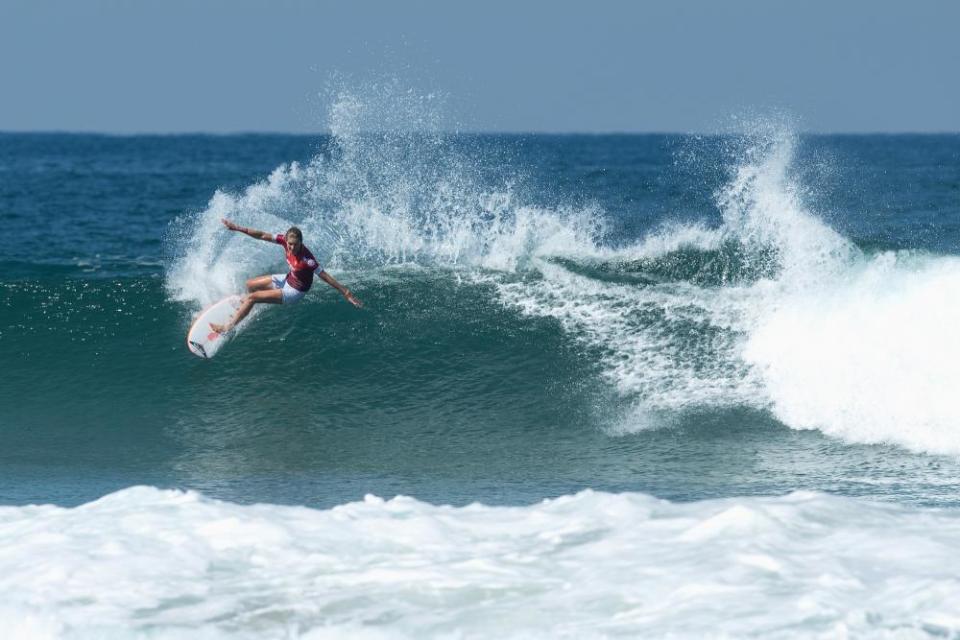Australia’s surfers seek to justify Olympic selection after rocky start to WSL

The day after Sally Fitzgibbons watched Cathy Freeman win the 400m gold medal at the Sydney Olympics, the nine-year-old donned her wetsuit and sprinted around town. Wearing neoprene in place of Freeman’s iconic space-age suit, Fitzgibbons imagined herself representing Australia at the Olympics.
“It sounds bizarre, because there was no pipeline for representing Australia in surfing back then, but it was always a dream,” Fitzgibbons tells Guardian Australia. “That visual was always there in my mind.” Twenty-one years later, Fitzgibbons will be wearing her nation’s green and gold when surfing makes its Olympic debut in Tokyo.
Related: Australian Olympic team to receive fast-track Covid vaccinations ahead of Tokyo Games
Fitzgibbons’ wetsuit/space-age suit moment in 2000 was perhaps a sign of the mixed sporting career that would follow. Inspired by Freeman’s heroics, which she had seen live from the stands in ANZ Stadium, a young Fitzgibbons pursued middle-distance running and won two gold medals at the 2007 Youth Olympics. “In my mind I was going to the Olympics as an athlete,” she says.
Despite giving up running en route to becoming a professional surfer, the lure of the Olympics always remained with Fitzgibbons – which made the sport’s inclusion in the Olympic program all the sweeter. “It’s come around full circle,” says the 30-year-old. “This is why you keep showing up. During my career I have had a few near misses at the title, a few times which have really stung the heart, but you just keep getting up to try again, because you never know what is around the corner.” Come July, the prospect of Olympic gold will be around the corner for Fitzgibbons and her compatriots.
But a long road remains to Tokyo. Australia’s Olympic surfers – Fitzgibbons, Stephanie Gilmore, Julian Wilson and Owen Wright – will be in action in Margaret River from Sunday for the latest leg of the World Surf League. They must then travel to El Salvador for the final pre-Olympics qualifying event, before contesting WSL competitions in California and Mexico in the build-up to the Games.
The quartet were selected based on WSL rankings – the top two Australian men and women – with one male and one female surfer in reserve. “That was one step of the selection process,” says Kate Wilcomes, national high performance director at Surfing Australia. “They then attended a qualifying International Surfing Association event, and now they have to attend another ISA event in May. Our athletes are provisionally qualified, but they have to attend that event in El Salvador to be eligible to compete in Tokyo.”
Fitzgibbons admits that she harbours nerves about leaving the country. “It’s challenging for sure, it’s nerve-wracking, all the emotions under the sun,” she says. “Once you leave the sanctuary of Australia it all becomes a bit more difficult.
“Leaving the country brings up nervous energy: can I overcome this, can I get through all these legs, and show up still healthy and ready to go in Tokyo? I don’t know the answer but I’m going to do my best. if something goes wrong then I just have to think I gave it my best shot. I want to go to Japan and I’m going to do my best to get there.”

Australia’s surfers were selected prior to the Covid-19-induced postponement of the Olympics last year, meaning their inclusion is based on form from 2019. Poor performances at the first two events of the WSL season, in Newcastle and Narrabeen, puts added pressure on the quartet. Fitzgibbons and Gilmore were both knocked out in the quarter-finals in Narrabeen, while neither Wilson or Wright made the quarters in either event. In contrast, reserve surfer Ryan Callinan made the quarter-final in Newcastle and youngster Morgan Cibilic did not bow out until the semis.
“We’re not concerned,” says Surfing Australia’s Wilcomes. “We have four of the world’s best surfers. They have so much talent and expertise that they bring. It is not ideal with those results, but there has been a break from competition and this is a great time to reflect, take away those learnings and put them into action in the competitions ahead.”
Fitzgibbons, meanwhile, acknowledges she was hoping for better results but remains optimistic. “The way the tour has progressed – where the level is at – it is so challenging to progress round to round. By all means I would have loved to show up and win all these Aussie events, we’re on our home turf, with an awesome crowd, but surfing has a lot of uncontrollables. Of course it still has a sting to it when the hooter goes and you don’t progress, but you have to process it, move forward and move on.”
Related: Australia's surfers aim for killer touch with Olympic team named after deadly jellyfish
Come Tokyo, Fitzgibbons is confident she will be able to perform. “I feel like I’ve done the work – I just need to play my cards right, at this end of the game it’s strategy,” she says. “In the last couple of events, heats have been determined by the tiniest things – the smallest decisions, or the wave being a few metres one way or the other. But if they can swing one way, as they did, I believe they can swing the other on a different day. You just have to keep showing up consistently. I have to do what I can to turn up with a clear mind, in the right space, and hope the wave gods are on our side.”
With her in Tokyo will be a cap, signed by Freeman. At the 2000 Olympics, Fitzgibbons sought out Freeman’s autograph after her win, but the crowd was too packed for the nine-year-old to squeeze through. “There were tears on the train home,” Fitzgibbons says. But 18 years later the surfer attended a training camp where Freeman spoke, and signed the hat.
“I’m going to take it to Tokyo with me and channel that energy,” Fitzgibbons says. “That was a proud moment. I remember it as a nine-year-old, Cathy lighting the flame, the whole story that is so entrenched in our cultural folklore. It’s just cool to be part of this timeline, to represent Australia in Tokyo. At the end of the day, to have Olympian next to your name will just be ‘wow, that’s crazy.’”

 Yahoo Finance
Yahoo Finance 